Arm Announces Mobile Armv9 CPU Microarchitectures: Cortex-X2, Cortex-A710 & Cortex-A510
by Andrei Frumusanu on May 25, 2021 9:00 AM EST- Posted in
- SoCs
- CPUs
- Arm
- Smartphones
- Mobile
- Cortex
- ARMv9
- Cortex-X2
- Cortex-A710
- Cortex-A510
New DSU-110 L3 & Cluster: Massively More Bandwidth
Alongside the new CPU microarchitectures, Arm today is also announcing a new L3 design in the form of the new DSU-110. The “DynamIQ Shared Unit” had been the company’s go-to cluster and “core complex” block ever since it was introduced in 2017 with the Cortex-A75 and Cortex-A55. While we’ve seen small iterative improvements, today’s DSU-110 marks a major change in how the DSU operates and how it promises to scale up in cache size and bandwidth.
The new DSU-110 is a ground-up redesign with an emphasis on more bandwidth and more power efficiency. It continues to be the core building block for all of Arm’s mobile and lower tier market segments.
A key metric is of course the increase of L3 cache configuration which will now go up to 16MB this generation. This is of course the high-end of the spectrum and generally we shouldn’t expect such a configuration in a mobile SoC soon, but Arm has had several slides depicting larger form-factor implementations using such a larger design housing up to 8 Cortex-X2 cores. This is undoubtedly extremely interesting for a higher-performance laptop use-case.
The bandwidth increase of the new design is also significant, and applies from single-thread to multi-threaded scenarios. The new DSU-110 promises aggregate bandwidth increases of up to 5x compared to the contemporary design. More interesting is the fact that it also significantly boosts single-core bandwidth, and Arm here actually notes that the new DSU can actually support more bandwidth than what’s actually capable of the new core microarchitectures for the time being.
Arm never really disclosed the internal topology of the previous generation DSU, but remarks that with the DSU-110 the company has shifted over to a bi-directional dual-ring transport topology, each with four ring-stops, and now supporting up to 8 cache slices. The dual-ring structure is used to reduce the latencies and hops between ring-stops and in shorten the paths between the cache slices and cores. Arm notes that they’ve tried to retain the same lower access latencies as on the current generation DSU (cache size increases aside), so we should be seeing very similar average latencies between the two generations.
Parallel access increases for bandwidth as well as more outstanding transactions seem to have been also very important in order to improve performance, which seems very exciting for upcoming SoC designs, but also puts into more question the previously presented CPU IPC improvements and exactly how much the new DSU-110 contributes to those numbers.
Architecturally, one important change to the capabilities of the DSU-110 is support for MTE tags, a upcoming security and debugging feature promising to greatly help with memory safety issues.
The new DSU can scale up to 4x AMBA CHI ports, meaning we’ll have up to 1024-bit total bi-directional bandwidth to the system memory. With a theoretical DSU clock of around 2GHz this would enable bandwidth of up to 256GB/s reads or writes, or double that when combined, plenty enough to be able to saturate also eventual high-end laptop configurations.
In terms of power efficiency, the new DSU offers more options for low-power operation when in idle situations, implementing partial L3 power-down, able to reduce leakage power of up to 75% compared to the current DSU.
In general idle situations but still having the full L3 powered on, the new design promises up to 25% reduction in leakage power all whilst offering 2x the bandwidth capabilities.
It’s important to note that we’re talking about leakage power here- active dynamic power is expected to generally scale linearly with the bandwidth increase of the new design, meaning 5x the bandwidth would also cost 5x the power. This would be an important factor to note into system power and in general the expected power behaviour of the next-gen SoCs when they’re put under heavy memory workloads.
Arm describes the DSU-110 as the backbone of the Armv9 cluster and that seemingly seems to be an apt description. The new bandwidth capabilities are sure to help out both with single-threaded, but also with multi-threaded performance of upcoming SoCs. Generally, the new 16MB L3 capability, while it’s possible somebody might do a high-end laptop SoC configuration, isn’t as exciting as the now finally expected move to a new 8MB L3 on mobile SoCs, hopefully also enabling higher power efficiency and more battery life for devices.


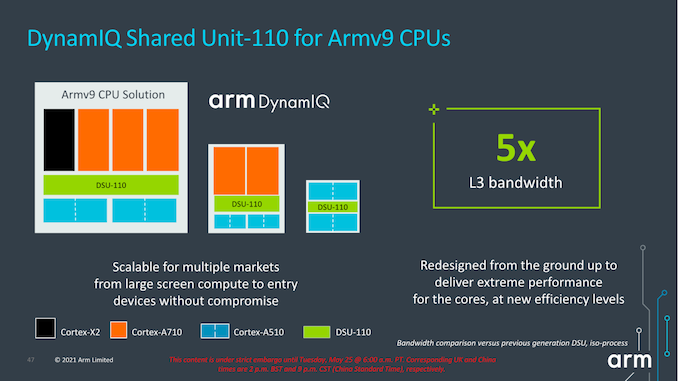
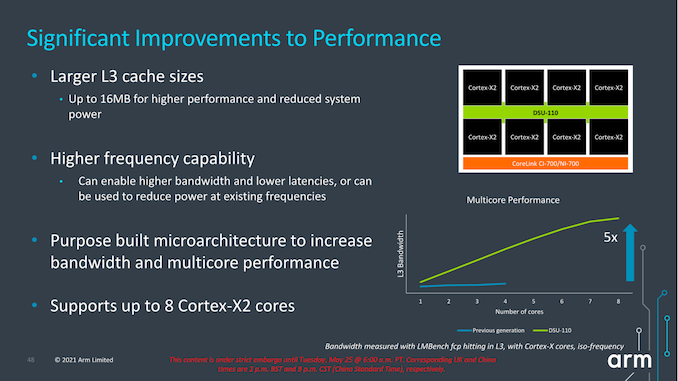
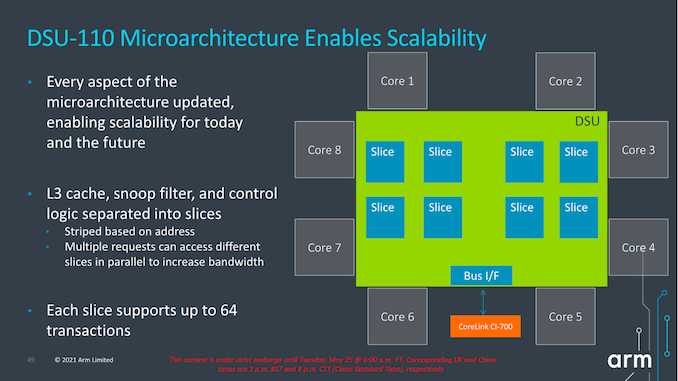
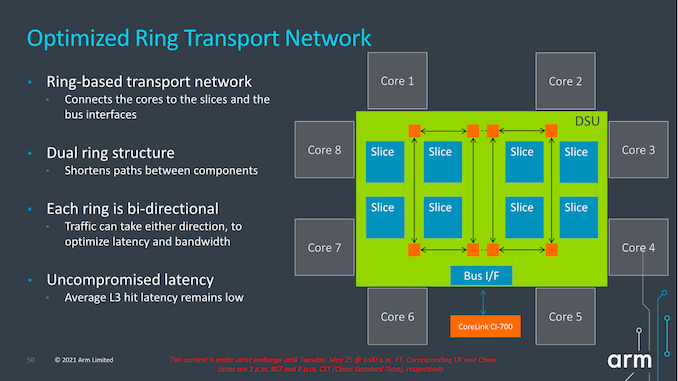
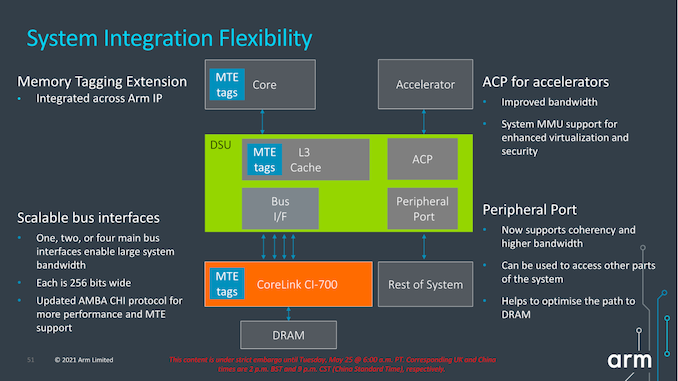

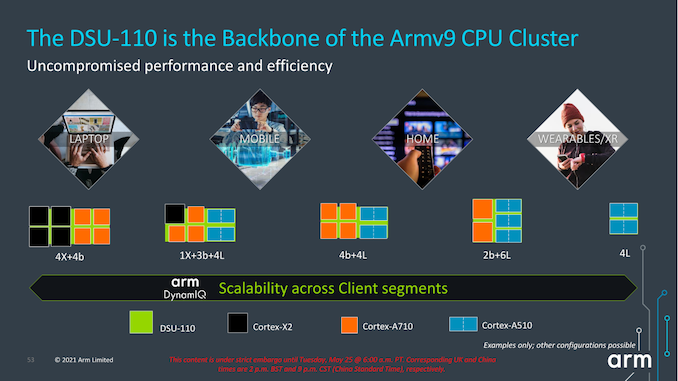








181 Comments
View All Comments
dotjaz - Wednesday, May 26, 2021 - link
Where do you even get expensive 32bit phones? There is no REAL shift other than Play Store policy which doesn't even affect end users.mode_13h - Wednesday, May 26, 2021 - link
Look up you phone specs on a site like gsmarena and see what cores it has. If any are ARM Cortex-A35, A5x, or A7x, then you already have a 64-bit phone.Most phones sold for the past 5 years have been 64-bit.
RSAUser - Wednesday, May 26, 2021 - link
Anything launched with lollipop or higher is most probably 64bit, so shouldn't be an issue.SarahKerrigan - Tuesday, May 25, 2021 - link
A55, But Wider And More Dozery was not what I expected.Still, it looks quite decent. Excited to see A710 and A510 in silicon. Not sure how to feel about X2.
The fun begins immediately! Or in about seven months, as the case may be!
eastcoast_pete - Tuesday, May 25, 2021 - link
I had a somewhat different reaction: the X2 makes some sense, it's a continuation of the X1 performance over efficiency approach, the 710 is the next big "A" core, and the 510 is, as Andrei wrote, a bit underwhelming. To me, it looks like ARM didn't even consider using their A65 design (OOO) and come up with a true contender for the perf/W crown for efficiency cores. Apple remains light years ahead here, and anyone in the non-iOS space is stuck with this attempt to inject some Bulldozer design features into the tired in-order A55 lineage. With no custom ARM-derived cores on the horizon (doubt if Google will surprise us with their custom SoC), what's next? RISC-V?SarahKerrigan - Tuesday, May 25, 2021 - link
No custom cores on the horizon? What about Nuvia and Ampere's cores?mode_13h - Tuesday, May 25, 2021 - link
There remains the outside possibility that AMD or Intel decides to enter the ARM race.ikjadoon - Tuesday, May 25, 2021 - link
I will not yet forgive AMD for binning Jim Keller's K12 design. Qualcomm, Arm, Apple all needed more competition in the perf-watt battle.mode_13h - Tuesday, May 25, 2021 - link
> I will not yet forgive AMD for binning Jim Keller's K12 design.It costs money to bring a chip to market, and AMD was deep in debt. Lisa Su barely managed to keep the lights on, with that Chinese licensing deal. And the market for ARM servers just wasn't ripe.
Assuming they really couldn't afford to do both (at least, without significant compromises), they definitely made the right call by going with x86.
mode_13h - Tuesday, May 25, 2021 - link
BTW, I agree that I'd love to see how well it compared to other ARM cores of its day, but we can't ignore the practical and business realities.I hope AMD will one day reveal more about the K12. That definitely won't happen as long as a potential successor is in the works!